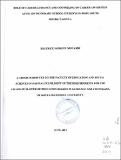| dc.contributor.author | Njogu, Sarah Wambeti | |
| dc.contributor.author | Kibaara, Tarsilla | |
| dc.contributor.author | Gichohi, Paul | |
| dc.date.accessioned | 2020-11-23T13:22:46Z | |
| dc.date.available | 2020-11-23T13:22:46Z | |
| dc.date.issued | 2019 | |
| dc.identifier.issn | 2663-9335 | |
| dc.identifier.uri | https://ajoeijournals.org/sys/index.php/ajoei/article/view/48 | |
| dc.identifier.uri | http://repository.kemu.ac.ke/handle/123456789/836 | |
| dc.description.abstract | Career guidance activities offered in public secondary schools are meant to assist students succeed in their careers after finishing O-level education. The knowledge that students acquires through career offices should therefore help them to remove confusion, anxiety, indecisiveness, and should empower them with information on clear career paths; relevant occupations in the context of their talents, academic abilities and market trends. The purpose of this study was to determine how career guidance services affect career choice among public secondary school students in Meru County, Kenya.However many secondary school students complete their studies without a clear understanding of the courses to enroll for upon joining institutions of higher learning. The study sought to examine the extent to which nature of career guidance services influence career choice of students in public secondary school in Meru County. Descriptive survey and correlational research designs were adopted in this study. Questionnaires and a structured interview schedule were used to collect data. Thirty six schools were sampled through stratified random sampling technique and an equal number of principals and career guidance teachers from sampled secondary schools obtained. Systemic sampling was used to sample 377 form four students while 11 parents were sampled using purposive sampling technique, making a total of 460 respondents. A pre-test on questionnaires was done to ensure validity while reliability was computed where Cronbach’s Alpha value was used. Data was then analyzed using Statistical Package for Social Sciences (SPSS) version 24 and Microsoft excel where, descriptive statistics (mean and standard deviation) and inferential statistic, that is, linear regression analysis was computed accordingly.The major findings were that most public secondary schools (78.8%) didn’t have professionally qualified career guidance teachers while 57.6% allocated less than 5% of operational budget to cater for career oriented activities.The study concluded that career guidance services were statistically significant in influencing career choice of students in public secondary schools. Establishment of fully fledged career guidance offices with well-trained career teachers and adequate funding can help achieve the planned career-oriented activities. This study recommends deliberate allocation of sufficient funds to run career guidance services and involvement of all in supporting this initiative. | en_US |
| dc.language.iso | en | en_US |
| dc.publisher | African Journal of Emerging Issues | en_US |
| dc.relation.ispartofseries | Vol. 1;No. 8 | |
| dc.subject | Career guidance services | en_US |
| dc.subject | career choice | en_US |
| dc.subject | career information services | en_US |
| dc.title | How Career Guidance Services Affect Career Choice among Public Secondary School Students in Meru County, Kenya | en_US |
| dc.type | Article | en_US |


